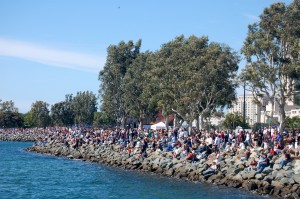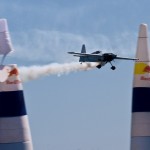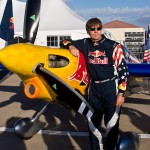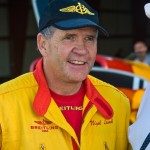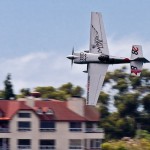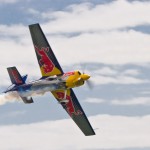By Bob Shane
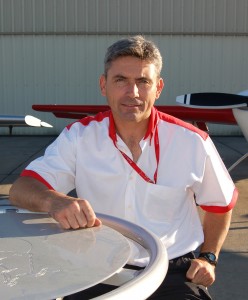
British pilot Paul Bonhomme, of Team Matador, moved back into first place in the Red Bull Air Race World Series after winning the San Diego Race.
With all the excitement of a Super Bowl, Red Bull brought its high-energy style of extreme air racing to San Diego on Sept. 21 and 22. More than 50,000 spectators viewed the high-performance aerial motor sport with amazement, as 13 of the world’s top pilots tore up the sky in a brilliant display of speed and precision. The race aircraft traveled at speeds of more than 250 miles per hour, flying as low as a mere 10 feet above the water. Pilots raced against the clock, pulling as much as 10 Gs, as they maneuvered through a maze of inflated air gates that constituted the racecourse. Here, success is measured in a millisecond, leaving no margin for error.
In addition to the Air Race, there were various demonstrations and fly-bys. The U.S. Navy and Coast Guard each simulated an air/sea helicopter rescue. Flybys included aircraft such as the E-2, C-2 and F-18 Super Hornet. Red Bull flew its MiG-17, and the elite Red Bull Air Force skydiving team performed precision parachuting. Red Bull’s Eurocopter (MBB) BO-105, piloted by Chuck Aaron, performed loops and rolls. It’s the only helicopter approved to perform aerobatics. A flyby of vintage aircraft included the P-51 and B-25.
San Diego was the ninth race in the 2007 Red Bull Air Race Series. The first year of the series, in 2005, consisted of seven races starting with Abu Dhabi, United Arab Emirates, followed by Rotterdam, Netherlands; Zeltweg, Austria; Rock of Cashel, Ireland; Longleat, UK; Budapest, Hungary; and San Francisco. In 2006, the race calendar included eight stops, again starting with Abu Dhabi, followed by Barcelona, Spain; Berlin, Germany; Istanbul, Turkey; Budapest; Longleat; San Francisco; and Perth, Australia. This year, 10 venues are on the race calendar. The series kicked off in Abu Dhabi, followed by Rio De Janeiro, Brazil; Monument Valley, U.S.; Istanbul; Interlaken, Switzerland; London; Budapest; Porto, Portugal; and San Diego, with a final race scheduled in Perth on Nov. 4.

American pilot Mike Mangold, of Team Cobra, finished fifth in the San Diego Race, moving him back into second place.
The Red Bull Air Race marked the kick off in San Diego of “Fleet Week.” Established by community and business leaders, Fleet Week has become an annual tradition and opportunity for the public to say thank you to the servicemen and women in the U.S. Navy, Marine Corps and Coast Guard. San Diego is a patriotic and pro-military city, and San Diego Fleet Week has become the nation’s largest military tribute.
“San Diego has served as host for many world class sporting events, and it’s a privilege to welcome the 2007 Red Bull Air Race World Series to our prestigious list,” said Mayor Jerry Sanders. “The Sports Council has delivered us an event that will not only showcase America’s finest city to more than 35 countries worldwide, but will also provide a spectacular new motor sport to our waterfront.”
On Aug. 8, as a precursor to the Red Bull Air Race, Kirby Chambliss made a historic flight, taking off from the deck of the retired aircraft carrier USS Midway. The ship, launched in 1945, was decommissioned on April 11, 1992. It was the longest serving carrier in the U.S. Navy’s history. After being stored in Bremerton, Wash., it arrived in San Diego on Jan. 5, 2004, where it now resides as San Diego’s Aircraft Carrier Museum.
Chambliss flew his Edge 540 to San Diego International Airport/Lindbergh Field (SAN). The plane was loaded on a flatbed truck at 3 a.m. and transported to the Midway, then placed on an elevator and raised up to the flight deck. A deck crew, wearing colored jerseys defining their role in the flight operation, came from the nuclear-powered USS Ronald Reagan, which was currently in port. The length of the flight deck is 968 feet; Chambliss figured he had 780 feet available for the takeoff.

Red Bull specialists had to repair a race pylon demolished by Mike Mangold’s plane during qualification.
The small crowd in attendance to witness the event couldn’t believe their eyes when Chambliss, laying down a curtain of smoke, performed his signature 90-degree “Cobra” takeoff from the flight deck with 150 feet to spare. When Chambliss stood his Edge 540 on its tail, pulling up into the vertical a few feet off the deck, a member of the launch crew commented, “He’s going to stall!” Chambliss’ ferry pilot reportedly said, “He was stalled before he ever left the deck!”
It was a flight for the record books. Chambliss flew into history as the pilot of the last propeller-driven airplane to take off from the Midway. He would make one more takeoff from the aircraft carrier during the air race.
It takes a great amount of planning and resources, such as equipment and personnel, to put on a Red Bull Air Race. The crew consists of 290 permanent Red Bull staff members from at least 19 different nations. It’s truly an international event; 132 networks in 66 different countries broadcast highlights of the race. Nearly 250 million people from around the world will get to view race segments on TV news broadcasts.
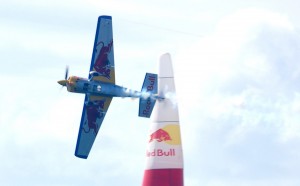
American pilot Kirby Chambliss, of Team Red Bull, demonstrates knife-edge flying past an air gate on the San Diego racecourse.
The racetrack erected in San Diego Bay sat in front of the famous Embarcadero Marina Park, across the harbor from Coronado. The San Diego track posed some new challenges for the race pilots. It was significantly different from the river tracks of the races in London and Porto. The narrow river tracks, with their restricted arrangement of air gates, limited the pilots to flying in the middle of the waterway. The San Diego course covered a much larger area, resulting in more twists and sharp turns and air gates that were more difficult to negotiate.
In an interview prior to Thursday’s training session, pilot Mike Mangold provided insight into the world of extreme air racing. A pilot with American Airlines, he also flew F-4s in the military.
“The strategy is to win every time I fly,” asserted a confident Mangold.
The aircraft of choice for Red Bull style racing is the Edge 540. This is the Mangold flies, and according to him, “No two are the same.” Everyone tries to get an advantage over the competition by making modifications to their aircraft. NASCAR and professional drag racing have influenced engine modifications. Covering the tail wheel and adding winglets are some of the aerodynamic changes that enhance aircraft performance.
“The blend of things in my airplane is optimized for this type of racing,” said Mangold.
One of the problems he sees is that because of constantly being on the road, “there’s little time to do testing.” Ironically, British pilot Paul Bonhomme has Mangold’s old airplane, which Mangold expressly set up for racing.
“Paul has the second best airplane suited for this form of racing and this course,” Mangold said.
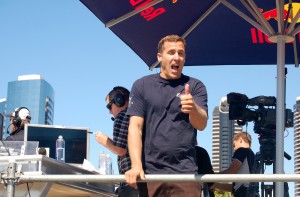
Red Bull announcer Jeff Burton was as animated while narrating the race as the aircraft were while making extreme maneuvers on the over-water course.
When asked about his concerns on the racecourse, Mangold responded, “I try not to hit pylons.” Hitting a pylon is a whopping 10-second penalty. His second fear is a mechanical failure. With respect to the layout of the San Diego track, Mangold said, “This is a thinking man’s course; it makes you think about where you’re going to turn.”
Mangold, from Victorville, Calif., was clearly the hometown favorite. With only two points separating Mangold from Bonhomme, in second place, the San Diego race promised to be an exciting one.
Thursday was a designated training session. The race stewards disqualified Mangold, leading in points, early in his training run for what they deemed “dangerous flying.” Mangold disagreed with the call and declined any comment on the subject. Bonhomme posted the fastest training time of 1 min. 26.51 sec., followed by Spain’s Alejandro Maclean, who was 2.34 seconds slower.
Friday was qualifications; a strong wind made for a treacherous racecourse and prompted pilots to adjust their tactics. Mangold, the first to try to qualify, hit a pylon, which resulted in a 10-second penalty. At the end of the day, he qualified in tenth position.
Chambliss posted the fastest qualifying time of 1 min., 26.56 sec., earning him the pole position for Saturday’s race. Peter Besenyei, who was .64 seconds slower, followed him.
San Diego meteorologists had been predicting ominous weather throughout the week. On Saturday, heavy rain showers passed over the downtown and bay area just hours before the start of racing. Strong winds off the Pacific Ocean were once again a factor, but not as bad as during Friday’s qualifications.
Prior to the commencement of race activity on Saturday, three of the Red Bull Air Race pilots celebrated their birthdays with a giant cake in the pilot’s lounge at their staging base, Brown Field Municipal Airport (SDM). Frank Versteegh, the “Flying Dutchman,” was born Sept. 19. Bonhomme and Austrian Hannes Arch share a Sept. 22 birthday, which this year happened to be race day.
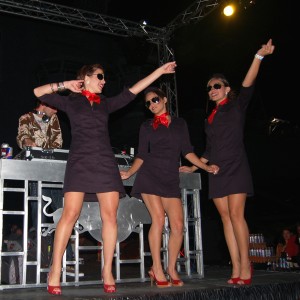
Staff members of the Red Bull Energy Team danced the night away at the sold out “Red Bull Friday” party on the deck of the USS Midway (CV-41).
“I hope to have something to celebrate after the race,” said Bonhomme, who turned 43. At that point, he had 39 points, placing him only two points behind Mangold.
Arch, now 40, said he feels like he’s getting younger with each birthday.
“I celebrated a little earlier than usual this year, last week in Austria with some of my best friends who came in from around the world,” he said.
Versteegh, now 53, wearing a baseball cap bearing the slogan “Old Men Rule,” was the 12th qualifier and happy to be going into the elimination round.
Saturday’s eliminations consisted of eight heat races. Eight pilots competed in the quarterfinals, with four pilots advancing to the semifinals and two pilots advancing to the final heat. The seventh heat race was a consolation final. All heat races are one-on-one duels between the pilots. Points, awarded by how the pilot places at each event, determine the winner. Six points are awarded for first place, five for second, four for third, three for fourth, two for fifth and one for sixth.
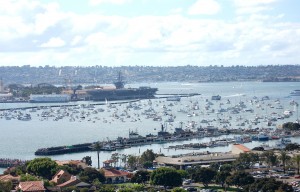
Passengers of more than 500 boats anchored outside the perimeter of the racecourse got a nautical view of the action taking place over San Diego Bay.
The battle for the 2007 championship, with just two races left, was essentially Mangold vs. Bonhomme. Bonhomme led the championship most of the season before Mangold jumped ahead in Budapest. When the smoke settled after the final round in San Diego, Bonhomme had regained the lead from Mangold for the Red Bull Air Race World Series Championship. Clocked at 1 min., 23.80 sec., Bonhomme moved ahead of Mangold by two points. Chambliss was second and Nigel Lamb was third.
“When I heard I had a 1.24 something, I thought I had it in the bag,” Chambliss commented. “I was really surprised when they called out a 1.23 for Paul.”
Mangold placed fifth. With only two points separating Bonhomme and Mangold, the final race in Perth, Australia, in November, promises to be an exciting finish to what was a thrilling season.
For complete race results, visit [http://www.redbullairraces.com].
- Team Cobra pilot Mike Mangold, in his Edge 540, struck a pylon during his first qualifying run.
- Defending Champion Kirby Chambliss flew his Zivko Edge 540 to second place.
- Nigel Lamb, Team Breitling, finished in third place.
- Austrian Hannes Arch, Team Cobra, carried a piece of pylon around the course.
- Hungarian Peter Besenyei, Team Red Bull, flew his Edge 540 to sixth place.













